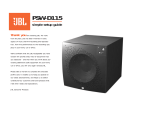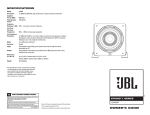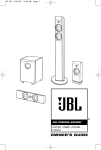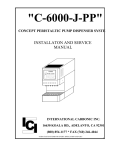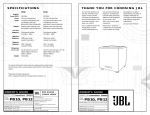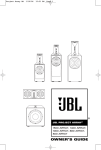Download JBL S120PII Subwoofer
Transcript
S P E C I F I C AT I O N S Amplifier Power (RMS): Driver: Inputs: Outputs: Low-Pass Frequency: High-Pass Frequency: Frequency Response: Dimensions (H x W x D): Weight: 400 Watts 12" PolyPlas™ (polymer-coated cellulose fiber) cone; rubber surround; SFG™; magnetic shorting rings; high-temp, oversized, fiberglass voice coil; HeatScape™ motor structure; cast-aluminum basket Line Level (switchable to LFE), BassQ™ and Speaker Level with gold-plated, 5-way binding posts BassQ and Speaker Level (High-Pass with gold-plated, 5-way binding posts) Continuously variable from 50Hz – 150Hz 150Hz when using speaker-level outputs 22Hz – Low-pass crossover setting 17-3/16" (with feet, without spikes) x 16-3/16" x 18" (19" with grille) 437mm (with feet, without spikes) x 411mm x 457mm (483mm with grille) 56 lb/25.5kg All features and specifications are subject to change without notice. * Trademarks of Dolby Laboratories. DTS is a registered trademark of Digital Theater Systems, Inc. OWNER’S GUIDE PRODUCT LINE: MODEL NUMBER: STUDIO™ PRO SOUND COMES HOME™ SERIES S120P II JBL Consumer Products 250 Crossways Park Drive, Woodbury, NY 11797 8500 Balboa Boulevard, Northridge, CA 91329 800-336-4JBL (4525) (USA only) D E S I G N G O A L : Bring the thrill of live performance and movie sound to the home environment by calling on JBL’s professional engineering leadership. www.jbl.com W O O F E R T Y P E : Pure-cellulose fiber JBL is a registered trademark of JBL, Incorporated. P O R T D E S I G N : FreeFlow™ flared Part No.: 338003-001 P R O F E S S I O N A L R E F E R E N C E : Studio Monitor © 2001 JBL, Incorporated THANK YOU FOR CHOOSING JBL For more than 50 years, JBL has been involved in every aspect of music and film recording and reproduction, from live performances to the recordings you play in your home, car or office. note of enjoyment that you expected – and that when you think about purchasing additional audio equipment for your home, car or office, you will once again choose JBL. you posted on our latest advancements, and helps us to better understand our customers and build products that meet their needs and expectations. We’re confident that the JBL loudspeakers you have chosen will provide every Please take a moment to complete the enclosed profile card. It enables us to keep JBL Consumer Products X + 0 + Y2 0 M HZ S120PII X + 0 + Y 2 0 M HZ” X + 0 + Y2 OWNER’S GUIDE PRODUCT LINE: STUDIO™ SERIES D E S I G N G O A L : Bring the thrill of live performance and movie sound to the home environment by calling on JBL’s professional engineering leadership. W O O F E R T Y P E : Pure-cellulose fiber P O R T D E S I G N : FreeFlow™ flared P R O F E S S I O N A L R E F E R E N C E : Studio Monitor READ THIS! CAUTION RISK OF ELECTRIC SHOCK DO NOT OPEN CAUTION: To prevent electric shock, do not use this (polarized) plug with an extension cord, receptacle or other outlet unless the blades can be fully inserted to prevent blade exposure. The lightning flash with arrowhead symbol, within an equilateral triangle, is intended to alert the user to the presence of uninsulated “dangerous voltage” within the product’s enclosure that may be of sufficient magnitude to constitute a risk of electric shock to persons. The exclamation point within an equilateral triangle is intended to alert the user to the presence of important operating and maintenance (servicing) instructions in the literature accompanying the appliance. 1. Read Instructions. All the safety and operating instructions should be read before the product is operated. 2. Retain Instructions. The safety and operating instructions should be retained for future reference. 3. Heed Warnings. All warnings on the product and in the operating instructions should be adhered to. 4. Follow Instructions. All operating and use instructions should be followed. 5. Cleaning. Unplug this product from the wall outlet before cleaning. Do not use liquid cleaners or aerosol cleaners. Use a damp cloth for cleaning. 6. Attachments. Do not use attachments not recommended by the product manufacturer, as they may cause hazards. 7. Water and Moisture. Do not use this product near water – for example, near a bathtub, wash bowl, kitchen sink or laundry tub; in a wet basement; or near a swimming pool; and the like. 8. Accessories. Do not place this product on an unstable cart, stand, tripod, bracket, or table. The product may fall, causing serious injury to a child or adult, and serious damage to the product. Use only with a cart, stand, tripod, bracket, or table recommended by the manufacturer, or sold with the product. Any mounting of the product should follow the manufacturer’s instructions, and should use a mounting accessory recommended by the manufacturer. 9. A Product and Cart Combination Should Be Moved with Care. Quick stops, excessive force, and uneven surfaces may cause the product and cart combination to overturn. 10. Ventilation. Slots and openings in the cabinet are provided for ventilation and to ensure reliable operation of the product and to protect it from overheating, and these openings must not be blocked or covered. The openings should never be blocked by placing the product on a bed, sofa, rug, or other similar surface. This product should not be placed in a built-in installation such as a bookcase or rack unless proper ventilation is provided or the manufacturer’s instructions have been adhered to. 2 Important Safety Precautions! 11. Power Sources. This product should be operated only from the type of power source indicated on the marking label. If you are not sure of the type of power supply to your home, consult your product dealer or local power company. For products intended to operate from battery power, or other sources, refer to the operating instructions. 12. Polarization. This product may be equipped with a polarized alternatingcurrent-line plug (a plug having one blade wider than the other). This plug will fit into the power outlet only one way. This is a safety feature. If you are unable to insert the plug fully into the outlet, try reversing the plug. If the plug should still fail to fit, contact your electrician to replace your obsolete outlet. Do not defeat the safety purpose of the polarized plug. 13. Power-Cord Protection. Power-supply cords should be routed so that they are not likely to be walked on or pinched by items placed upon or against them, paying particular attention to cords at plugs, convenience receptacles, and the point where they exit from the product. 14. Nonuse Periods. The power cord of the product should be unplugged from the outlet when left unused for long periods of time. 15. Outdoor Antenna Grounding. If an outside antenna or cable system is connected to the product, be sure the antenna or cable system is grounded so as to provide some protection against voltage surges and builtup static charges. Article 810 of the National Electrical Code, ANSI/NFPA 70, provides information with regard to proper grounding of the mast and supporting structure, grounding of the lead-in wire to an antenna discharge unit, size of grounding conductors, location of antenna-discharge unit, connection to grounding electrodes, and requirements for the grounding electrode. See Figure A. 16. Lightning. For added protection for this product during a lightning storm, or when it is left unattended and unused for long periods of time, unplug it from the wall outlet and disconnect the antenna or cable system. This will prevent damage to the product due to lightning and power-line surges. 17. Power Lines. An outside antenna system should not be located in the vicinity of overhead power lines or other electric light or power circuits, or where it can fall into such power lines or circuits. When installing an outside antenna system, extreme care should be taken to keep from touching such power lines or circuits, as contact with them might be fatal. 18. Overloading. Do not overload wall outlets, extension cords, or integral convenience receptacles, as this can result in a risk of fire or electric shock. 19. Object and Liquid Entry. Never push objects of any kind into this product through openings, as they may touch dangerous voltage points or short-out parts that could result in a fire or electric shock. Never spill liquid of any kind on the product. 20. Servicing. Do not attempt to service this product yourself, as opening or removing covers may expose you to dangerous voltage or other hazards. Refer all servicing to qualified service personnel. 21. Damage Requiring Service. Unplug this product from the wall outlet and refer servicing to qualified service personnel under the following conditions: a. The power-supply cord or the plug has been damaged; or b. Objects have fallen onto, or liquid has been spilled into, the product; or c. The product has been exposed to rain or water; or d. The product does not operate normally when following the operating instructions. Adjust only those controls that are covered by the operating instructions, as an improper adjustment of other controls may result in damage and will often require extensive work by a qualified technician to restore the product to its normal operation; or e. The product has been dropped or damaged in any way; or f. The product exhibits a distinct change in performance – this indicates a need for service. 22. Replacement Parts. When replacement parts are required, be sure the service technician has used replacement parts specified by the manufacturer or that have the same characteristics as the original part. Unauthorized substitutions may result in fire, electric shock or other hazards. 23. Safety Check. Upon completion of any service or repairs to this product, ask the service technician to perform safety checks to determine that the product is in proper operating condition. 24. Wall or Ceiling Mounting. The product should be mounted to a wall or ceiling only as recommended by the manufacturer. 25. Heat. The product should be situated away from heat sources such as radiators, heat registers, stoves, or other products (including amplifiers) that produce heat. Figure A. Example of Antenna Grounding as per National Electrical Code, ANSI/NFPA 70 Antenna Lead-In Wire Ground Clamp Antenna Discharge Unit (NEC Section 810-20) Grounding Conductors (NEC Section 810-21) Electric Service Equipment Ground Clamps Power Service Grounding Electrode System (NEC Art 250, Part H) SPEAKER PLACEMENT • As a general rule, bass response increases as a subwoofer is placed closer to a wall. Therefore, bass output is maximized when the subwoofer is placed in a corner. • It is also recommended that the subwoofer be positioned along the same wall as the front loudspeakers. Low-frequency sounds are normally omnidirectional, meaning the listener can’t tell where they are generated from. However, frequencies between 75Hz – 150Hz can be localized, especially at higher volume levels. Positioning your subwoofer as recommended will provide the most natural soundstage and imaging from your loudspeaker system. Remember that these are just guidelines. Since every listening room is different, JBL strongly recommends experimenting with the positioning of your subwoofer to obtain the most pleasing results in your room. One technique that can help you find the ideal subwoofer location is to temporarily place the subwoofer near the main listening location. Then move around the room and determine where you hear the most pleasing bass performance. This would then be the ideal location for the subwoofer. SPEAKER CONNECTION When we designed the S120PII powered subwoofer, our goal was to offer the user the best possible performance combined with the most flexible and complete installation options. Please look over the following three examples to determine which description best matches your system and follow the corresponding hookup instructions. To use the binding-post speaker terminals •ª with bare wire, unscrew the collar until the pass-through hole in the center post is visible under the collar. Insert the bare end of the wire through the hole in the post, then screw the collar back down until the connection is tight. The holes in the center of the collars are intended for banana-type connectors. Right Front Left Front Dolby* Pro Logic* (Non-Digital) – Speaker Level Use this installation method for Dolby Pro Logic applications (not Dolby Digital, DTS® or other digital processing), where the receiver/processor does not have a subwoofer output or a volume-controlled preamp (line-) level output: and right terminals on the subwoofer that are marked “High Level In” •. Connect the left and right terminals on the subwoofer that are marked “High Level Out” ª to the corresponding terminals on the back of your front left and right speakers. If your receiver features bass management capabilities that require you to configure your speaker settings, make sure to set your left- and right-front speakers to “LARGE”. Connect your receiver or amplifier’s center, left and right surround-speaker terminals to the corresponding terminals on the back of your center, left and right surround speakers. Connect your receiver or amplifier’s front left and right speaker terminals to the left Center + – + + – – Subwoofer LL • HIGH LEVEL IN + RR – L HIGH LEVEL OUT` ª R Receiver Left Front + – Left Surround + – Left Surround + – Center + Right Front – + – Right Surround + – Right Surround + – 3 Dolby Pro Logic (Non-Digital) – Line Level Use this installation method for Dolby Pro Logic applications (not Dolby Digital, DTS or other digital processing), where the receiver/processor is equipped with a subwoofer output or a volume-controlled preamp (line-) level output: Use RCA-type patch cords to connect the line-level subwoofer outputs on your receiver or amplifier to the Line Level inputs ¶ on the subwoofer. IMPORTANT: Make sure that the LFE toggle switch ™ on the subwoofer is in the “Normal” position. Do not use the “LFE” position with Dolby Pro Logic-only processors. Note: If your receiver or amplifier only has one subwoofer output jack, then you may connect the subwoofer output on your receiver/preamplifier to either the left or right Line Level input ¶ on the subwoofer. It makes no difference which jack you choose. terminals on your receiver or amplifier. Make sure your receiver or processor is configured correctly: Make sure that the subwoofer is configured as “On.” Note for advanced users: If your receiver/processor has a built-in low-pass crossover filter for the subwoofer output, then the LFE switch ™ should be set to the “LFE” position to bypass the subwoofer’s internal crossover. Connect each speaker to the corresponding speaker ¡ ™ £ 180° LFE ON 0° NORMAL OFF PHASE RECEIVER ¢ 80Hz Subwoofer Out L AUTO CROSSOVER FREQUENCY R 50Hz BASSQ (See owner’s manual before use) ∞ LEVEL 150Hz IN MIN OUT MAX R L LINE LEVEL IN (For LFE use R or L) § ¶ L HIGH LEVEL IN • HIGH LEVEL OUT ª R + – L R 4 Dolby Digital or DTS (or Other Digital Surround Mode) Connection Use this installation method for Dolby Digital, DTS or other digital surround processors: IMPORTANT: Make sure that the LFE toggle switch ™ on the subwoofer is in the “LFE” position. Use the Line Level input jacks ¶ for the LowFrequency Effects channel. Connect these jacks to the LFE output or subwoofer output on your receiver or amplifier. Note: If your receiver or amplifier has only one subwoofer output jack, then you may connect the subwoofer output on your receiver/preamplifier to either the left or right Line Level input ¶ on the subwoofer. It makes no difference which jack you choose. Connect each speaker to the corresponding speaker terminals on your receiver or amplifier. Make sure that you have configured your surround sound processor for “Subwoofer On” or “LFE On.” The front left, front right, center and rear speakers should be set to “Small” or “Large” depending on their size and frequency response. Consult your receiver’s or processor’s owner’s manual. ¡ ™ £ 180° LFE ON 0° NORMAL OFF PHASE AUTO ¢ 80Hz RECEIVER/PREAMPLIFIER CROSSOVER FREQUENCY Subwoofer Output/LFE 50Hz BASSQ (See owner’s manual before use) ∞ LEVEL 150Hz IN MIN OUT MAX § R L LINE LEVEL IN (For LFE use R or L) ¶ L HIGH LEVEL IN • HIGH LEVEL OUT ª R + – L R BassQ™ Jacks The jacks marked “BassQ” § are for use with the JBL BassQ bass equalization module that will be released in the near future. The BassQ will enable you to optimize your system’s bass response by equalizing the output of multiple subwoofers to best match your listening environment. DO NOT connect these jacks to any other device. Do not use the BassQ jacks § without having first read the BassQ owner’s manual. 5 O P E R AT I O N Power The S120PII is equipped with both a master Power switch ‚ and an Auto turn-on/turnoff switch £. In order to function, the S120PII must be plugged into an active electrical outlet (but not an accessories outlet on another component of your audio system such as a receiver), and the master Power switch ‚ must be turned on (the “•” position). The Auto turn-on/turn-off switch £ has three positions: On The subwoofer is on at all times and ready to play program material. Auto As long as no audio signal is received, the subwoofer is in Standby mode to conserve power, indicated by the red color of the LEDs on the front of the unit. When an audio signal is sensed, the subwoofer will switch itself into the fully On mode and begin playing the program material. The LEDs will turn green. When a period of about twenty minutes goes by during which no signal is sensed, the S120PII will return to Standby mode, indicated by the LEDs turning red. Off The subwoofer is off at all times, even if an audio signal is present at its inputs. If you plan to be away for an extended time, or if the subwoofer will not be used, you may wish to turn off the master Power switch ‚. room size, subwoofer placement, type of main speakers and listener position. Adjust the subwoofer level so that the volume of the bass information is pleasing to you. When using a Dolby Digital/ DTS receiver, adjust the LFE level on the receiver to 0dB, and then adjust the subwoofer Level Control ∞ for the desired amount of bass. between 120Hz – 150Hz. This control ¢ is not used when the LFE switch ™ is in the “LFE” position. Level Control The subwoofer Level Control ∞ adjusts the volume of the subwoofer relative to the rest of the system. Proper level adjustment depends on several variables such as Crossover Adjustments The Crossover Frequency Control ¢ determines the highest frequency at which the subwoofer reproduces sounds. If your main speakers can comfortably reproduce some low-frequency sounds, set this control ¢ to a lower frequency setting, between 50Hz – 100Hz. This will concentrate the subwoofer’s efforts on the ultradeep bass sounds required by today’s films and music. If you are using smaller bookshelf speakers that do not extend to the lower bass frequencies, set the low-pass Crossover control ¢ to a higher setting, 6 ¡ ™ £ 180° LFE ON 0° NORMAL OFF PHASE AUTO 80Hz ¢ CROSSOVER FREQUENCY § ¶ LEVEL 50Hz ∞ BASSQ (See owner’s manual before use) 150Hz IN MIN OUT MAX R L L S120PII CAUTION RISK OF ELECTRIC SHOCK DO NOT OPEN WARNING: TO REDUCE THE RISK OF FIRE OR ELECTRIC SHOCK, DO NOT EXPOSE THIS APPLIANCE TO RAIN OR MOISTURE. HIGH LEVEL IN • LINE LEVEL IN (For LFE use R or L) AVERTISSEMENT: POUR PRÉVENIR LES RISQUES D’INCENDIE OU DE CHOC ÉLECTRIQUE ÉVITER D’EXPOSER CET APPAREIL A LA PLUIE OU A L’HUMIDITÉ. R + – ON L ª HIGH LEVEL OUT R ‚ OFF Phase Control subwoofer placement and listener position. Adjust the Phase switch ¡ to maximize bass output at the listening position. The Phase Control ¡ determines whether the subwoofer’s piston-like action moves in and out in phase with the main speakers or opposite the main speakers. There is no correct or incorrect setting. Proper phase adjustment depends on several variables such as Remember, every system, room and listener is different. There are no right or wrong settings; this switch ¡ offers the added flexibility to adjust your subwoofer for optimum performance for your specific listening conditions without having to move your speakers. If at some time in the future you happen to rearrange your listening room and move your speakers, you should experiment with the Phase switch ¡ in both positions, and leave it in the position that maximizes bass performance. TROUBLESHOOTING If you used the High Level (speaker) inputs • and there is no sound from any of the speakers: • Check that receiver/amplifier is on and a source is playing. • Check that powered subwoofer is plugged into an active electrical outlet and is switched on £‚. • Check all wires and connections between receiver/amplifier and speakers. Make sure all wires are connected. Make sure none of the speaker wires are frayed, cut or punctured. Make sure no wires are touching other wires or terminals and creating a short circuit. • Review proper operation of your receiver/amplifier. If there is low (or no) bass output: • Make sure the connections to the left and right “Speaker Inputs” • have the correct polarity (+ and –). • Make sure that the subwoofer is plugged into an active electrical outlet and that both power switches are on £‚. • Adjust the Crossover point ¢. • Flip the Phase Control switch ¡ to the opposite position. • If you are using a Dolby Digital/DTS receiver or processor, make sure that the subwoofer adjustments on the receiver/processor are set up correctly. When using the S120PII’s Speaker Level inputs •, you should set your receiver to configure the main left and right speakers as “LARGE”. • Slowly turn the Level Control ∞ clockwise until you begin to hear the desired amount of bass. If you used the Line Level inputs ¶ and there is no sound from the subwoofer: • Check that receiver/amplifier is on and a source is playing. • Check that powered subwoofer is plugged into an active electrical outlet and that both Power switches are on £‚. • Check all wires and connections between receiver/ amplifier and subwoofer. Make sure all wires are connected. Make sure none of the wires are frayed, cut or punctured. • Review proper operation of your receiver/amplifier. • Slowly turn the Level Control ∞ clockwise until you begin to hear the desired amount of bass. • Make sure that you have configured your receiver/ processor so that the subwoofer/LFE output is on. 7








